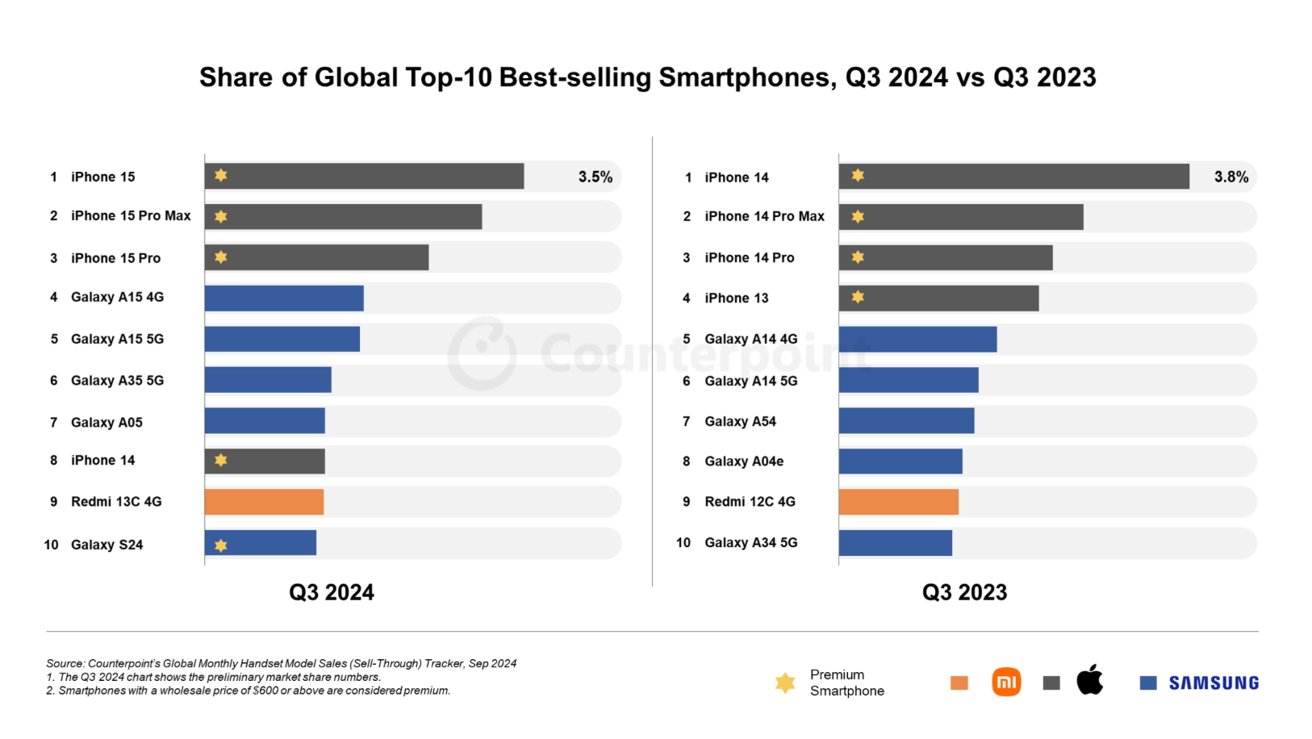Apple's iPhone 15 soared to the top of global smartphone sales in 2024, marking a new wave of demand for premium tech and flashy features.
Counterpoint Research shows that Apple's iPhone 15 and Pro counterparts topped global sales in the third quarter of 2024. Samsung and Xiaomi held positions in the top ten, indicating a stable but competitive smartphone market.
The iPhone 15's success comes when high-end smartphones gain broader consumer interest. Pro Series models made up half of Apple's iPhone sales for the first time in a third quarter, highlighting the growing demand for advanced features.
The data from Q3 2024 reveals that Apple's iPhone 15 lineup dominated global smartphone sales, with the base iPhone 15 model leading the pack at 3.5% of market share. Following closely were the iPhone 15 Pro Max and iPhone 15 Pro, reflecting Apple's strong presence in the premium segment.
Samsung's Galaxy A15 4G and Galaxy A15 5G took the fourth and fifth spots, showing the brand's competitive hold in the mid-range market. Other Samsung models, including the Galaxy A35 5G, Galaxy A05, and Galaxy S24, also made it into the top 10, cementing Samsung's broad market appeal.
Xiaomi's Redmi 13C 4G smartphone secured the ninth position, appealing primarily to budget-conscious consumers, while Apple's older iPhone 14 continued to rank at eighth. In comparison, Q3 2023 saw a similar structure with iPhones leading.

The iPhone 15's global success reflects multiple factors. The data suggests that Apple's strategy to offer financing and trade-in options has expanded access to its devices, appealing to a broader audience.
These incentives and a strong reputation for high-quality, user-friendly technology make iPhones increasingly accessible across diverse income groups. Apple's competitors also benefit from market shifts, particularly in regions where affordability is critical.
Premium versus budget smartphones
With economic constraints reducing purchasing power, demand for budget-friendly and mid-range smartphones has surged. Samsung's Galaxy A series, offering competitive pricing, extensive availability, and extended software support, appeals to value-conscious customers.
Xiaomi, on the other hand, has made inroads in emerging markets with models like the Redmi 13C, which provides robust features at a lower price point. That approach allows Xiaomi to meet the needs of budget-sensitive consumers while still offering desirable smartphone capabilities.
By positioning models with accessible prices and solid performance, Samsung and Xiaomi are well-positioned to capitalize on the growing demand for affordable devices, a trend strengthened by global economic pressures and a widening income gap.
The iPhone 15's success in global sales reflects not just Apple's brand strength but also a shift in consumer preferences toward higher-end features. During the first six months after launch, the Pro models dominated sales, appealing to early adopters and tech enthusiasts willing to pay a premium.
Sales shifted to the standard, non-Pro models after the initial surge, indicating a change in buyer demographics. Budget-conscious consumers, drawn by trade-in programs, financing, or the new iPhone's affordability, entered the market.
The non-Pro models, though less expensive, offered core Apple experiences and sufficient power for most users, making them practical for the broader market.